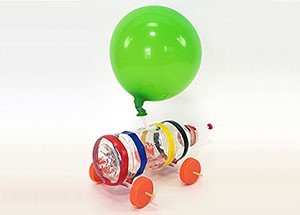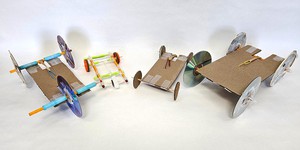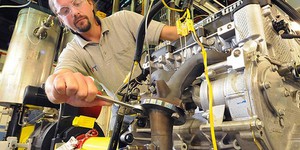Summary
Introduction
Build a balloon-powered car from recycled materials in this fun activity. You can even grab a friend, build two cars, and race them against each other!
Materials
Note: other materials can be substituted, like a small cardboard box instead of a plastic bottle.
- Plastic bottles
- Plastic bottle caps (4)
- Flexible straws (3)
- Wooden skewers (2)
- Balloon
- Rubber band
- Tape
- Scissors
- Hobby knife
-
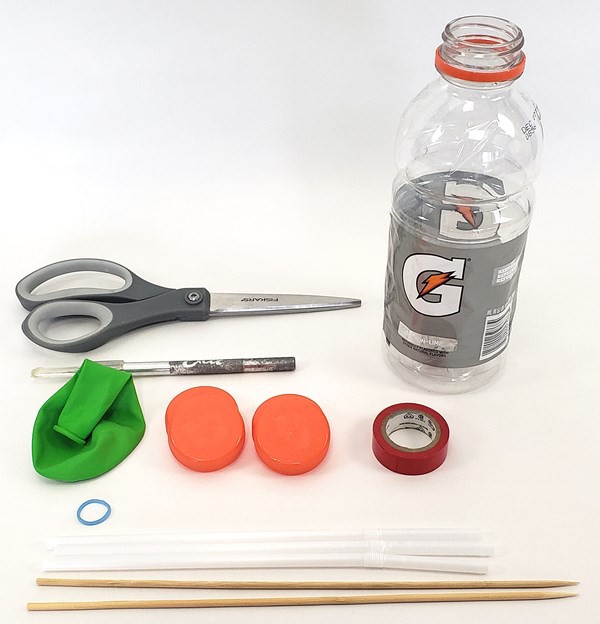 Image Credit: Ben Finio, Science Buddies / Science Buddies
Image Credit: Ben Finio, Science Buddies / Science Buddies
Prep Work
Instructions
- Cut two straws so they are slightly longer than the width of the bottle.
- Tape the straws to the bottle. Make sure they are parallel.
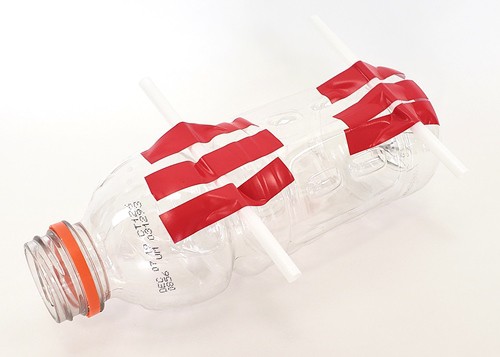 Image Credit: Ben Finio, Science Buddies / Science Buddies
Image Credit: Ben Finio, Science Buddies / Science Buddies
- Cut the skewers so they are slightly longer than the straws.
- Use the hobby knife to make small holes in the center of all four bottle caps.
- Push a skewer through one of the holes.
- Thread the skewer through one of the straws, pointy end first.
- Push a bottle cap onto the other end of the skewer. This makes an axle with two wheels.
- Repeat steps 5–7 to make a second axle.
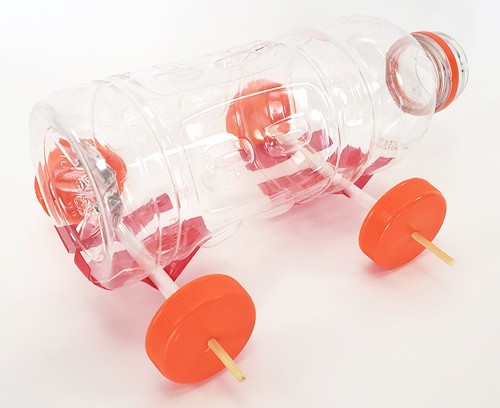 Image Credit: Ben Finio, Science Buddies / Science Buddies
Image Credit: Ben Finio, Science Buddies / Science Buddies
- Make sure your axles spin freely. Put the car down and make sure it rolls smoothly. It might get stuck if the wheels wobble or the axles are not parallel. Adjust them if needed.
- Slide the short end of the third straw into the neck of the balloon.
- Tightly wrap a rubber band around the neck of the balloon.
 Image Credit: Ben Finio, Science Buddies / Science Buddies
Image Credit: Ben Finio, Science Buddies / Science Buddies
- Blow the balloon up through the straw to make sure there are no leaks.
- Cut a small hole (big enough for the straw) in the top of the car.
- Press the free end of the straw through the small hole and out the mouth of the bottle.
- Tape the straw so it points backwards, not down.
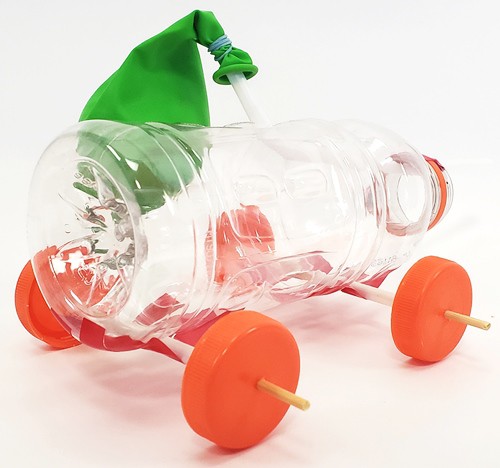 Image Credit: Ben Finio, Science Buddies / Science Buddies
Image Credit: Ben Finio, Science Buddies / Science Buddies
- Inflate your balloon; then put the car down and release! Cover the tip of the straw with your fingertip to keep the air in the balloon until you put it down.How far does your car go?
- If your car does not move at all, or moves very slowly, inflate the balloon more and try again.
- If your car still does not move, double check your axles to make sure they spin freely. If the wheels and axles are not aligned, the balloon might not be strong enough to push the car forward.
What Happened?
When you inflate the balloon, put your car down, and release, your car should start to move forward. It will keep moving until the balloon runs out of air. If you did a good job aligning your wheels and axles, it might keep rolling for a little bit even after the balloon runs out of air, until eventually coming to a stop. Read the Digging Deeper section to learn about the physics behind your balloon car!
Digging Deeper
Your balloon car is a great demonstration of all three of Newton's laws of motion! However, we are going to explain them in reverse order:
Newton's third law of motion states that for every action, there is an equal and opposite reaction. When the balloon deflates, escaping air is pushed out the back of the balloon. In turn, the air pushes the car forward.
Newton's second law of motion is summarized by the famous equation F=ma, or that the net force acting on an object equals its mass times its acceleration. Acceleration is a change in velocity. You witness this as the car accelerates forward when the balloon deflates, and again as the car coasts to a stop (decelerates) when friction slows it down.
Newton's first law of motion states that an object in motion will remain in motion, and an object at rest will remain at rest, unless acted upon by an outside force. You may notice this is your car keeps moving even after the balloon has completely deflated. The car is already moving forward, so even though the balloon is no longer pushing it, it will keep moving until an outside force (friction) brings it to a stop.
You can also think about this activity in terms of energy. When you inflate the balloon, it stores potential energy (in both the stretched rubber and the compressed air inside). When you release the balloon, this stored potential energy is converted to kinetic energy, the energy of motion. Eventually, the car will come to a stop, but the energy is not lost—it is converted to other forms like sound and heat (from friction). The total amount of energy is conserved.
Ask an Expert
For Further Exploration
- These instructions show just one way to build a balloon car, but you do not have to use the exact materials listed. Try to improvise and use other materials, like a cardboard box for the body instead of a plastic bottle.
- Can you build a car with a different power source, like the wind or rubber bands? See the Additional Resources section for suggestions.
- Build two cars with different designs and race them against each other, or get a friend to build a car.
- This activity is a great way to practice the engineering design process. Can you improve your car to make it go farther?


